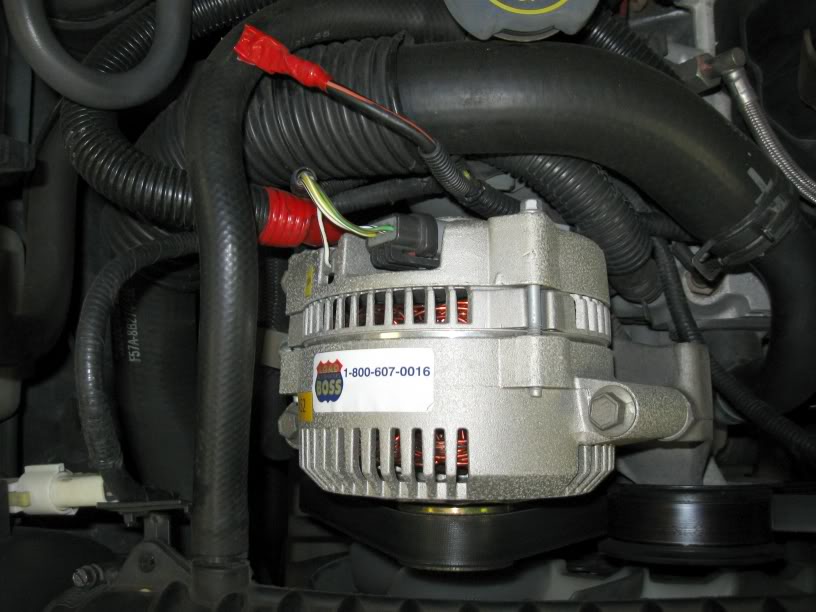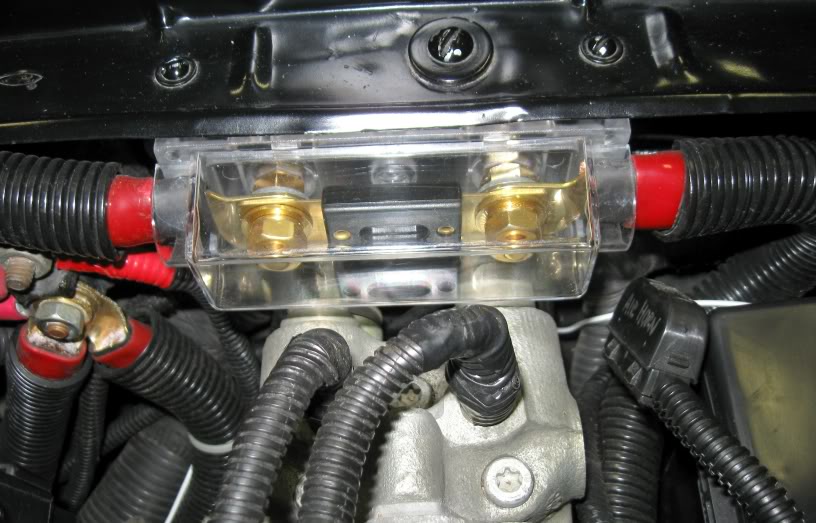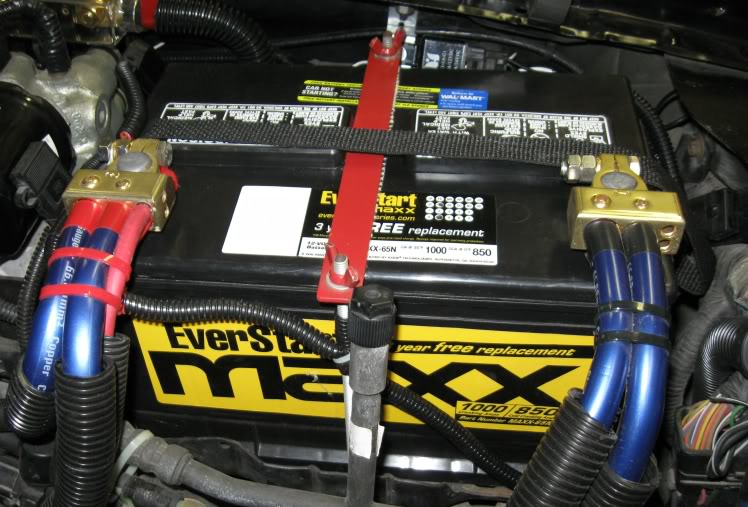Alternator Upgrade
#1
so my voltgage has been droping rather low at night when i have my heater, lights, aux lights, and stero going when im sitting at a light. i had my local shop take a look at it and they found a bolt that was loose on the back of the alternator. ( this was about a month ago) now it is still doing the same thing i have the battery checked and the alternator checked both cheaked out good but im still convinced that it is the altnator. i talke to my local shop and the said i should replace it with the sam size but i have been doing some reading and other say its okay to put a bigger alternator in my truck
i have a 2003 ford ranger edge with the 4.0 engine and my shop told me that it has the 130 amp alternator in it
if anyone has some advice i could use it
i have a 2003 ford ranger edge with the 4.0 engine and my shop told me that it has the 130 amp alternator in it
if anyone has some advice i could use it
#2
There should be several higher amperage alternators available for the SOHC 4.0Ls but they're most likely sourced from Explorers. I don't have the motivation or the energy right now to do the search, but DO NOT buy from the earlier (late 90s and earlier) 4.0Ls and especially the OHV 4.0Ls as they use a slightly different alternator. I have a Bosch 130 amp alternator from a '98 Explorer that I had in my previous '93 4.0L Ranger, and tried to swap it into my current '09 Ranger. It was an absolute no go, wiring was all wrong and there was something else holding me back about it too, mounting or the sort but I can't remember now.
Your '03 *should* have come stock with a 116 amp alternator, but IMO its not really worth spending the money to upgrade to a 130 amp unit as you most likely won't find enough of a difference to make it worthwhile. Its absolutely fine to install a larger unit in your truck, you're not going to hurt anything but it doesn't hurt to install a 4 ga charge wire as well and run it directly off the back of your alternator straight to your battery (the alternator is internally regulated so its fine). Make sure that there's a 150 amp fuse in between though for safety sake. I did this on my '93, plus was running dual Optima batteries but to be completely honest, I found it really didn't make that huge difference at the end of the day. It took longer to drain down the batteries but of course longer to charge them back up. The only time that I felt that it really helped was when I was running the winch, it would keep up a slight bit better.
IMHO, your best bet would be to install the largest output quality battery that you can afford (and not from Walmart, go directly to a battery retailer if possible and talk to someone who's knowledgeable with them) and go with something like an Odyssey or Deka battery AGM (sealed cell glass mat), or the top end Interstates are pretty good too (they're the guys who make Optima's - which is a good battery too but I've heard rumours about them being made in China now and that their quality is going downhill, but if you do go this route opt for a Yellowtop if possible). The other thing to do is remove your alternator and take it into a shop that specializes in rebuilding them and ask if they can rebuild it with heavier internals. I have heard of shops being able to bump them up to close to 160 amps and still get reliable life from them, but you're still going to be rather limited by the relatively small factory charge wire coming off the back of the alternator.
Hopefully, this wasn't too confusing but short of spending a bit of cash we're all pretty much stuck with lights dimming at idle. Mine's only 18 months old and I'm running a larger-than-stock Yellowtop Optima, and my lights still flicker a bit in drive at idle. Its not hurting anything, and honestly its just more annoying that anything. If you're running a standard tranny it may not hurt to bump your idle up to 800 rpm if possible, that should keep the stock unit spinning fast enough to get a solid output, whereas at the factory-set you're not spinning it fast enough to get the job done. An aftermarket smaller diameter pulley would essentially do the same thing as well, but I've never done the search so I don't know what's available out there. Thats all the ideas I can think of. LR
Your '03 *should* have come stock with a 116 amp alternator, but IMO its not really worth spending the money to upgrade to a 130 amp unit as you most likely won't find enough of a difference to make it worthwhile. Its absolutely fine to install a larger unit in your truck, you're not going to hurt anything but it doesn't hurt to install a 4 ga charge wire as well and run it directly off the back of your alternator straight to your battery (the alternator is internally regulated so its fine). Make sure that there's a 150 amp fuse in between though for safety sake. I did this on my '93, plus was running dual Optima batteries but to be completely honest, I found it really didn't make that huge difference at the end of the day. It took longer to drain down the batteries but of course longer to charge them back up. The only time that I felt that it really helped was when I was running the winch, it would keep up a slight bit better.
IMHO, your best bet would be to install the largest output quality battery that you can afford (and not from Walmart, go directly to a battery retailer if possible and talk to someone who's knowledgeable with them) and go with something like an Odyssey or Deka battery AGM (sealed cell glass mat), or the top end Interstates are pretty good too (they're the guys who make Optima's - which is a good battery too but I've heard rumours about them being made in China now and that their quality is going downhill, but if you do go this route opt for a Yellowtop if possible). The other thing to do is remove your alternator and take it into a shop that specializes in rebuilding them and ask if they can rebuild it with heavier internals. I have heard of shops being able to bump them up to close to 160 amps and still get reliable life from them, but you're still going to be rather limited by the relatively small factory charge wire coming off the back of the alternator.
Hopefully, this wasn't too confusing but short of spending a bit of cash we're all pretty much stuck with lights dimming at idle. Mine's only 18 months old and I'm running a larger-than-stock Yellowtop Optima, and my lights still flicker a bit in drive at idle. Its not hurting anything, and honestly its just more annoying that anything. If you're running a standard tranny it may not hurt to bump your idle up to 800 rpm if possible, that should keep the stock unit spinning fast enough to get a solid output, whereas at the factory-set you're not spinning it fast enough to get the job done. An aftermarket smaller diameter pulley would essentially do the same thing as well, but I've never done the search so I don't know what's available out there. Thats all the ideas I can think of. LR
#3
#4
#5

Here's my 200a alternator, I've had it for a couple years now. Got it off evilBay from an alternator company for about $250 shipped.
If you upgrade alternators, you'll need to upgrade the power & ground wires (search BIG 3).
Mine outputs 200a at idle, a lot only output 100a or less at idle so do a little research before you buy one.
My voltage at idle usually sets at 14.4v to 15.0v since the upgrade, no matter how much stuff I have on.
#7
The ground on an alternator is through the body, isn't it?
In the pic, you can see the wire with red tape on the end sticking up - thats the OEM charge wire. The other red one thats attached to the back of the alternator is his aftermarket setup and goes directly to the battery - there's another 6ga wire going from the battery to the fuse panel so you need to worry about power in the cab. It is very simple to upgrade, and as much as fuses are optional if you protect it protect it properly (no different than your 4ga starter wire that's unfused), but it is a very wise idea to install on though. I'm too tired and sick right now to do a search for one, but a Bussman 150 amp inline fuse (should be 5/16" bolts on either side) will work. Guys use them for inverters and the such (thats where I sourced mine from, my old 1750w inverter). LR
In the pic, you can see the wire with red tape on the end sticking up - thats the OEM charge wire. The other red one thats attached to the back of the alternator is his aftermarket setup and goes directly to the battery - there's another 6ga wire going from the battery to the fuse panel so you need to worry about power in the cab. It is very simple to upgrade, and as much as fuses are optional if you protect it protect it properly (no different than your 4ga starter wire that's unfused), but it is a very wise idea to install on though. I'm too tired and sick right now to do a search for one, but a Bussman 150 amp inline fuse (should be 5/16" bolts on either side) will work. Guys use them for inverters and the such (thats where I sourced mine from, my old 1750w inverter). LR
#8
Yup, it grounds through the body of the alternator. Some guys run a wire off one of the mounting bolts back to the battery, but I don't think it's necessary.
The OEM wire (red tape over the end) was barely a 6ga wire if that big.
My new wire 1/0ga is the one in the upper left side of the alternator with the wire loom & red tape around the loom.
It was a bear fishing that huge cable back the same way the OEM wire went too.
I used these ANL fuse holders for protection with a 250a wafer fuse.

That's actually the fuse for my stereo, but the one that's on the alternator is buried & can't be seen that well.
I already had these style battery terminals, but I modded them to accept 2x 1/0ga cables as well as the other cables I have on there (old pic). I've since added a 4ga cable that's coming off the bolt with a ring terminal...it feeds a distribution block that feeds smaller stuff like fog lights, etc.

My wire is KnuKonceptz 1/0ga copper clad aluminum with is actually a little larger than 1/0ga. It was the cheaper version of their cable & if I had it to do again, I'd get the more flexible (and more expensive) cable they have.
Most people say you can get by with 4ga with a 200a alternator, but for a few bucks more you can go with the 1/0ga.
I've got a couple of those fuse holders & a couple sets of the battery terminals (not modded for 2x 1/0ga wires yet) if anyone is interested in buying some.
The OEM wire (red tape over the end) was barely a 6ga wire if that big.
My new wire 1/0ga is the one in the upper left side of the alternator with the wire loom & red tape around the loom.
It was a bear fishing that huge cable back the same way the OEM wire went too.
I used these ANL fuse holders for protection with a 250a wafer fuse.

That's actually the fuse for my stereo, but the one that's on the alternator is buried & can't be seen that well.
I already had these style battery terminals, but I modded them to accept 2x 1/0ga cables as well as the other cables I have on there (old pic). I've since added a 4ga cable that's coming off the bolt with a ring terminal...it feeds a distribution block that feeds smaller stuff like fog lights, etc.

My wire is KnuKonceptz 1/0ga copper clad aluminum with is actually a little larger than 1/0ga. It was the cheaper version of their cable & if I had it to do again, I'd get the more flexible (and more expensive) cable they have.
Most people say you can get by with 4ga with a 200a alternator, but for a few bucks more you can go with the 1/0ga.
I've got a couple of those fuse holders & a couple sets of the battery terminals (not modded for 2x 1/0ga wires yet) if anyone is interested in buying some.
#10
buggman you have thrown me off alittle has to what you have the fuses protecting and how the others wire are. As of this moment i under stand that you have a 1 gauge wire going from the alternator to the battery to charge and then a 1 gauge ground wire coming off the alternator to the chassie ground
#11
For power, the 1/0ga runs from the alternator to the fuse, from the fuse to the OEM solenoid, from OEM solenoid to the battery.
It's recommended to have a fuse between the alternator & the positive battery terminal or the solenoid where the OEM wiring was connected. My alt is a 200a & I used the next higher fuse at 250a just for a little headroom.
Some people run the alternator wire directly to the battery, but I'd rather do the extra work than to have something short out & catch on fire.
The 2nd fuse on the fender comes from the battery & goes in through the firewall back to my amplifier distribution power block where it divides to the amps.
The grounds go from the battery to the body, from the body to the frame... I went a little overboard as usual, most people only have one ground wire but I had the extra wire & put it to good use.
It's recommended to have a fuse between the alternator & the positive battery terminal or the solenoid where the OEM wiring was connected. My alt is a 200a & I used the next higher fuse at 250a just for a little headroom.
Some people run the alternator wire directly to the battery, but I'd rather do the extra work than to have something short out & catch on fire.
The 2nd fuse on the fender comes from the battery & goes in through the firewall back to my amplifier distribution power block where it divides to the amps.
The grounds go from the battery to the body, from the body to the frame... I went a little overboard as usual, most people only have one ground wire but I had the extra wire & put it to good use.
#12
#15
Absolutely, unless you're running a competition setup like buggman's (holy crap thats some serious hardware in there dude!). If you are planning on running a true 200 amp unit then 2 or 0 ga would be a good idea, but my Warn M8000 winch uses 2 ga and it stalls out around 430 amps according to the website... I'm pretty sure 4 ga will take the usual 130 - 150 load that it will actually be seeing without any issues. Technically, your ground wire can be one size smaller and still be ok, and you already have a 4 ga cable from the factory on the ground. LR
#16
Here's a LINK to a wire gauge chart I found via a quick google search.
Looks like 4ga is rated at 135a & 1/0ga is rated at 245a.
My amplifiers max out at about 100a if they were both to be at max power draw so I just went with 1/0ga back to them in case I ever want to add anything later on like a power inverter, etc.
Seems like the 4ga was only about $25 cheaper than the 1/0ga so that's why I used 1/0 for everything.
Looks like 4ga is rated at 135a & 1/0ga is rated at 245a.
My amplifiers max out at about 100a if they were both to be at max power draw so I just went with 1/0ga back to them in case I ever want to add anything later on like a power inverter, etc.
Seems like the 4ga was only about $25 cheaper than the 1/0ga so that's why I used 1/0 for everything.
Thread
Thread Starter
Forum
Replies
Last Post
Goodysgotacuda
2.9L & 3.0L V6 Tech
7
03-24-2009 09:40 PM









